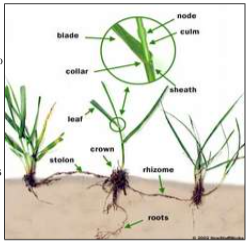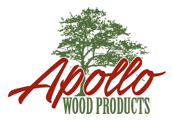HOW TO MANAGE NATIVE TURF AREAS
Soils Solutions and Delta Bluegrass Company are in our 16th year of development of our California Native Grass Sods we are delighted with the acceptance of this product in the marketplace. This new treatment of California Native grass species has brought about the need to educate those who are maintaining these turf areas about their unique establishment needs, watering and growth habits.
5 NATIVE BLENDS :
Native BentgrassTM is our best true lawn alternative. However, it should be noted that the desired mowing height should be decided early after planting and remain consistent throughout it’s long lifespan. When the lawn is allowed to grow over 2 inches beyond the desired mow height the Bentgrass will produce a false crown. This means that the stem of the plant can rise several inches above the soil level and the
leaf blade becomes raised. The result can be that when mowing occurs the green leaf is completely removed and all that remains is the straw colored stem of the plant. Recovery must begin from a new shoot of the plant in order for the green leaf to replace the stem. Depending on the season this process can take 4 to 8 weeks. (See Plant Diagram Under Mowing Below)
Delta Native Mow FreeTM and Delta Grasslands MixTM are 2 more lawn alternatives for the urban landscape. Their diverse growth habit allows you to mow garden pathways and create “play meadows”. When areas are not mowed, the grass will reach a height of 10 to 12 inches and then begin to layover on itself. Extension risers on irrigation heads that raise up 12 to 18 inches are recommended to achieve proper overhead irrigation coverage on non-mowed areas.
Native Preservation MixTM and Native Biofiltration SodTM have been developed for environmental applications such as roadsides, bio-swales, retention basins, storm water channels and riparian
restoration projects. In these applications our native grasses control soil erosion, slow the flow of water, and recharge ground water as they filter out heavy metals and other toxins before they enter our waterways.
Irrigated Applications: These Native sods have been extensively tested by California’s major agricultural colleges and schools and proven to require half the water of historical lawn grass choices. Most environmental installations are non-mowed and may be cut back only a few times a year. This commonly occurs in the mid to l late spring to remove the florets or seed heads and in the summer when there is a chance of it becoming a fire hazard. A string trimmer or weed eater is the most commonly used landscape tool. To maintain healthy green color NEVER remove more than 1/3 of the leaf blade with any single mow cycle (see diagram below).
Non-Irrigated Applications: Native sod blends will establish and actively grow during CA.’s cooler and wet season. The specially selected combination of native grasses found in our sod, if left non- irrigated. will go dormant during the summer becoming golden summer fields and then green up in
the fall to become beautiful cool season meadows. Temporary or supplemental irrigation is required during the establishment period.
If possible one or two deep irrigations should be applied to dormant stands to maintain moisture deep in. the soil keeping the roots hydrated. As with irrigated stands of grass, seasonal mowing may be implemented.
TEMPORARY IRRIGATION
Temporary or supplemental irrigation during the establishment period is required to ensure a strong
root system. Whether the area is non-irrigated or irrigated by a subsurface system such as NetafimTM, ABOVE ground water must be applied in order to maintain moisture in the top 1/4 inch of the soil.
CRITTER CONTROL
Burrowing animals such as gophers or moles can inflict big damage on your turf. One gopher can
create several mounds in a day. The most effective way to combat the destructive and very costly impact of gophers is to bury wire mesh below the grounds surface. Though costly and labor intensive, such a barrier will prevent gophers from burrowing to the surface.
MOWING
 The desired appearance and projected use will determine mowing height and frequency. Native BentgrassTM
The desired appearance and projected use will determine mowing height and frequency. Native BentgrassTM
is the industry’s first choice for native lawn areas. Maintained at a 2 to 3 inch mowing height provides
an exceptional turfgrass surface. Mowing height has a lot to do with the overall health of your lawn.
NEVER remove more than 1/3 of the leaf blade per mow cycle. To best understand what defines a LEAF BLADE please examine the adjacent diagram.
Cutting the leaf blade involves the part of the plant that grows above the crown. Removing more than 1/3 can damage the plant and cause it to die back and thus taking several weeks or longer to make a recovery. Our Native BentgrassTM has both rhizomes and stolons. A rhizome is an underground plant stem that is capable of producing the shoot and stem of a new plant. Stolons are shoots that grow horizontally above the ground and produce roots. This process can raise the crown of the plant and significantly affect the mowing height. If you wish to maintain
a playable surface it is essential that you consistently mow the area to the preferred height. The finer bladed fine fescue varieties used in our Native Mow FreeTM can be difficult to mow once the plant is falling over on itself. Well timed mowing can prevent open areas from occurring from the grass shading itself out when the grass is not cut before it reaches 10 – 12 inches tall.
IRRIGATION
With irrigation, California Native Sod will maintain its green color all year long. Once your turf has rooted the
irrigation should be adjusted to only apply water between 12:00 to 4:00 am. No daytime water should be applied. Irrigation is a very fluid dynamic with the amount of water applied dependent upon many factors. They include, temperature, length of day, season, rainfall and soil type (sandy or heavy soil). These effects can determine your need to increase or decrease the frequency of your irrigation. Strong wind conditions can severely affect the uniformity of irrigation. Wind can further increase the rate of evaporation of moisture from the turf. Delta Bluegrass has conducted extensive drought studies to determine that our native sod requires 50% Less Water than traditional turfgrass species. Local irrigation standards can be found at the California Department of Water Resources website and by referencing CIMIS (California Irrigation Management Information System) to find water application rates local to your area. In the warm season, apply water every 3rd day in a “CYCLE SOAK” method. For example, apply 15 minutes at 12:00 am and then follow an hour later with an additional 15 minutes. This allows the first application of water to penetrate into the soil with the second application driving it deeper into
the soil where the roots will chase after it going deep and increasing the drought tolerance of the grass.
SEASONAL CHARACTERISTICS
The versatile nature of our California Native Sod provides many different mowing options. In an unmowed setting the height of the plant can reach 12 to 18 inches. Native BentgrassTM, Delta Native Mow FreeTM
and Delta Grasslands MixTM the plant growth reaches 8 to 10 inches then bends over creating a meadow effect. In the spring the natural progression of the grasses is to try to reproduce. This is when seed heads will emerge in an upright stand above the grasses. Most seeds produced in an ornamental setting are sterile. However, the Native BentgrassTM can produce a small amount of seed that will blow around and often germinate in adjacent areas. To the untrained eye, these seed heads are often mistaken as weeds. If their appearance is deemed to be undesirable, they can be removed. This is usually in the mid and late spring.
A string trimmer (weed eater) or Flail type mower is the most commonly used landscape tool to cut the grass to the preferred height.
FERTILIZATION
Requirements for native sod are less than conventional turf. Generally, for native sod 2 – 3 pounds of
actual nitrogen per year is adequate. Apply in the early fall before the heavy rains arrive. Follow with an early spring (late February or early March) application. A third application may be necessary in the late spring or early summer. Watch for signs of low fertility, uneven growth and loss of color which are a good indication that an area needs fertilizer. The use of a slow release fertilizer such as BEST Super Turf 25-5-5 will prevent spiked leaf growth which could cause irrigation and disease issues. Apply at a rate of 6 pounds per 1,000 square feet or 1.5 pounds of actual nitrogen per fertilizer application.
